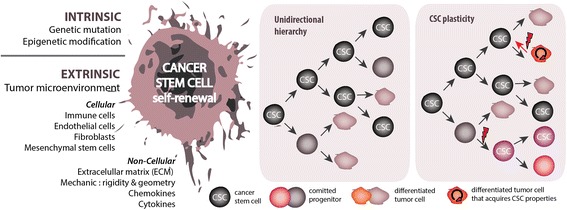Fig. 1.

The original CSC model (unidirectional hierarchy) assumes that only CSCs are able to generate the bulk of tumor via symmetric division (to self-renew) or asymmetric division (to generate differentiated cells). In this case, the hierarchy is strictly unidirectional and precludes the concept of cell fate reversibility from the progenitor cells. In contrast, accumulating evidence demonstrate that the hierarchy is more fluid than originally thought. In the CSCs plasticity model, (cancer) cell posses the dynamic ability of bidirectional conversion from a non-CSC state to a CSC state and vice versa. In this model, the stemness and CSCs plasticity are determined by diverse intrinsic and extrinsic cues that work simultaneously or independently overtime. Consequently, non-CSCs can serve as reservoir to create CSC populations throughout tumorigenesis. In the figure this is indicated with a lightning bolt and can be the result of a microenvironmental cue or a (epi-)genetic change
